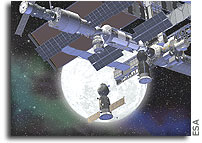NASA Space Station On-Orbit Status 30 November 2004

SpaceRef note: This NASA Headquarters internal status report, as presented here, contains additional, original material produced by SpaceRef.com (copyright © 2004) to enhance access to related status reports and NASA activities.
All ISS systems continue to function nominally, except those noted previously or below. Crew rest day after yesterday s successful Soyuz TMA-5/9S relocation.
With all Russian segment (RS) systems and the OpsLAN network yesterday restored to nominal operation, CDR Chiao today reconfigured the ITCS (internal thermal control system) in the U.S. segment (USOS) to manned mode, disassembling and restowing rack jumpers and jumper plugs, then switching the ITCS to single LTL (low temperature loop) configuration.
Chiao also disconnected the UOP/DCP (utility outlet panel/display & control panel) power bypass cable at the RWS (robotics workstation), required for the video coverage of the relocation with the Canadian SSRMS (Space Station Remote Manipulator System) wrist joint camera.
With the O2-producing Elektron electrolysis machine turned off, FE Sharipov started the monthly regeneration cycle of the BMP micropurification unit, today on absorbent bed #1 of the regenerable dual-channel filtration system (which currently uses the same AVK-5 vacuum vent valve as the Elektron). [Regeneration of each of the two harmful impurities absorption beds takes about 24 hours. The Elektron will then be powered up again.]
Sharipov conducted a 15-min tagup with specialists of the Russian SOP fire detection subsystem via VHF audio.
The crew performed their daily 2.5-hr. physical exercise program on TVIS treadmill, RED exerciser, and VELO cycle with bungee cord load trainer.
Afterwards, Leroy transferred the daily TVIS and RED exercise data files to the MEC (medical equipment computer) and also conducted the periodic transfer of accumulated data files from the wristband HRM (heart rate monitor) receiver stations to the MEC for downlink, followed by their erasure on the HRM storage medium.
Salizhan conducted the daily routine maintenance of the SOZh environmental control & life support systems in the Service Module (SM), including the weekly inspection of the BRPK air/liquid condensate separator apparatus.
Leroy Chiao set up the SM’s amateur radio equipment and at 11:25am EST engaged in a 10-min. ham radio exchange with students at the cole Secondaire (Secondary School) Fernand-Lefebvre, Sorel-Tracy, Quebec/Canada. [The exchange, in English, was transmitted throughout the school via intercom, so that all students and teachers could participate.]
|
Previous Reports ISS On-orbit Status [HQ] |
Russian equipment temporarily stowed in the Node will be relocated to the DC1 to clear access to U.S. fire suppression ports. A list of the gear, to be used for IMS (inventory management system) database updating, was uplinked overnight from TsUP/Moscow.
MCC-H sent up a list of options for this weekend s Saturday Science program. Since Science Officer Chiao is scheduled to perform test #4 of the ISSI (In Space Soldering Investigation) experiment on Friday (12/3), a leading option would be to follow through with test #5, the last run to complete this experiment, on Saturday.
Today’s CEO photo targets, no longer limited in the current LVLH attitude, were Muglad Basin fans, SW Sudan (weather was clear over the megafans for detailed mapping. High-resolution nadir image swaths across wetland regions and areas of highly contorted drainage are useful for delineation of individual fan boundaries), Tunis, Tunisia (this nadir overpass provided an opportunity for high-resolution photography. Mapping swaths from the urban-rural fringe through the urban center are useful for monitoring of city growth and land cover/land use change), High Central Andean Glaciers, S. American (opportunity for imaging of the northernmost Andean glaciers. Detailed images of the smaller ice fields and mountain glaciers are important as changes in glacial margins and area were clearly visible), and Internal Waves, Bahamas (weather was predicted to be mostly clear for internal wave photography. The sunglint point was to the right of track over the northern coastline of Haiti).
CEO photography can be viewed and studied at the websites:
See also the website “Space Station Challenge” at:
To view the latest photos taken by the expedition 10 crew visit:
- http://spaceflight.nasa.gov/gallery/images/station/crew-10/ndxpage1.html at NASA’s Human Spaceflight website.
Expedition 10 Flight Crew Plans can be found at http://spaceflight.nasa.gov/station/timelines/
Previous NASA ISS On-orbit Status Reports can be found here. Previous NASA Space Station Status Reports can be found here. Previous NASA Space Shuttle Processing Status Reports can be found here. A collection of all of these reports and other materials relating to Return to Flight for the Space Shuttle fleet can be found here.
Upcoming Key Events:
- Progress 15P undocking & destructive reentry — 12/23;
- Progress 16P launch — 12/24;
- Progress 16B docking — 12/26;
- EVA-12 — January 2005 (1/27?).
|
ISS Location NOW |
ISS Orbit (as of this morning, 6:46am EST [= epoch]):
- Mean altitude — 356.3 km
- Apogee height — 359.4 km
- Perigee height — 353.3 km
- Period — 91.67 min.
- Inclination (to Equator) — 51.64 deg
- Eccentricity — 0.0004568
- Solar Beta Angle — -51.7 deg (magnitude increasing)
- Orbits per 24-hr. day — 15.71
- Mean altitude loss in last 24 hours — 150 m
- Revolutions since FGB/Zarya launch (Nov. 98) — 34444
ISS Altitude History
Apogee height — Mean Altitude — Perigee height

For more on ISS orbit and worldwide ISS naked-eye visibility dates/times, see http://www.hq.nasa.gov/osf/station/viewing/issvis.html. In addition, information on International Space Station sighting opportunities can be found at http://spaceflight.nasa.gov/realdata/sightings/ on NASA’s Human Spaceflight website. The current location of the International Space Station can be found at http://science.nasa.gov/temp/StationLoc.html at NASA’s Marshall Space Flight Center. Additional satellite tracking resources can be found at http://www.spaceref.com/iss/tracking.html.










